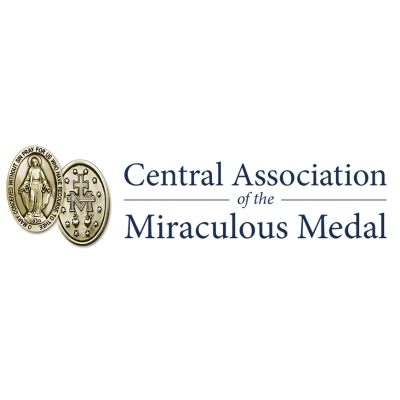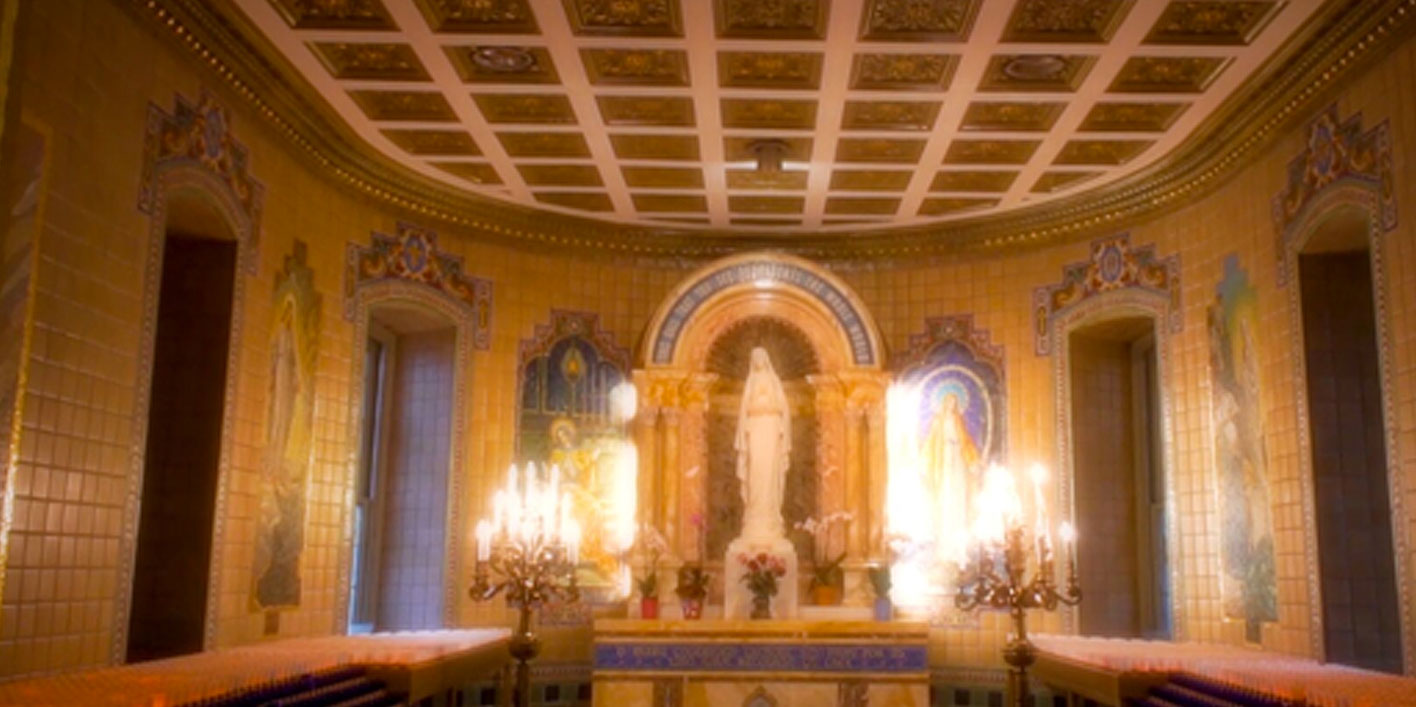A Home for Mary
Popes throughout the ages have encouraged the faithful to travel to shrines and holy sites. They know that our faith is enlivened when we travel with purpose and prayer to these hallowed places. Even the journey itself can be cleansing and renewing, as we leave our daily lives behind—if only for a few hours—and move from the secular to the sacred. Every step, every mile, can help us shed the weight of our daily lives.
December 8, 2019, the feast of the Immaculate Conception, marks the 140th anniversary of the dedication of The Miraculous Medal Shrine in Philadelphia. For the past 140 years, the Shrine has been a place where pilgrims can experience Our Lady, her beauty, and her grace. It is a fitting home for Our Blessed Mother and her Miraculous Medal, and people from around the world make pilgrimages to the Shrine, seeking countless graces through Our Lady’s intercession.
In a 2018 Vatican address to the International Conference of the Rectors and Pastoral Workers of Shrines (whose theme was “The Shrine: An Open Door to New Evangelization”), Pope Francis acknowledges these Marian graces: “Most of our shrines are dedicated to Marian piety. Here, the Virgin Mary opens the arms of her maternal love to listen to the prayer of each person and to fulfill it. […] Here Mary becomes the companion on the path of every person who raises their eyes to her asking for grace, certain it will be granted.”
In his short address, the Pope also reminded shrine leaders that these holy sanctuaries serve as both devotion and witness to the faith. “The shrine is a privileged place
to experience mercy that knows no boundaries. […] In fact, when mercy is lived, it becomes a form of real evangelization, because it transforms those who receive mercy into witnesses of mercy.”
How the Shrine became a place “to experience mercy” is a storied journey, filled with divine providence, faithful stewards, and the impassioned efforts of the Vincentians, who are its guardians.
FROM A HUMBLE CHAPEL TO A GLORIOUS SHRINE
The Shrine didn’t begin as a shrine at all, but rather as a seminary chapel.
To accommodate a staggering increase in Vincentian vocations, the Congregation of the Mission purchased a plot of land in the Germantown section of Philadelphia, which would become St. Vincent Seminary in 1865. From a portion of this seminary, the Shrine would soon arise.
Vincentian seminarians moved from Missouri to Philadelphia in 1868 (in part because of the American Civil War), the same year the cornerstone of St. Vincent’s Seminary was laid. In 1872, the seminary construction was completed, and the next year, plans were developed to build a chapel for the Vincentian Priests, Brothers, and Seminarians. Upon hearing of the plans, then-Bishop of Philadelphia, (soonto-be Archbishop) James Frederick Wood, asked the Vincentians to allow the chapel to be open to the public. The Vincentians agreed, and plans were redrawn so that the chapel entrance would face the predominately residential Chelten Avenue. The cornerstone of the chapel was placed in 1875, and four years later, Archbishop Patrick John Ryan of Philadelphia blessed the Chapel of the Immaculate Conception.
Fast-forward to 1915, when The Central Association of the Miraculous Medal was founded by the Vincentians with Fr. Joseph A. Skelly, CM, as its director. Empowered by the Blessed Mother’s intercession and fueled by Fr. Skelly’s tireless efforts, local and national devotion to the Miraculous Medal skyrocketed by 1927. In response, Fr. Skelly commissioned the building of a shrine to Our Lady of the Miraculous Medal in the Chapel of the Immaculate Conception. To accommodate the Shrine, Fr. Skelly chose to extend the west transept of the chapel at the site of the altar of St. Vincent de Paul. Thus, The Miraculous Medal Shrine was established.
Building the Shrine would have been enough to secure Fr. Skelly’s celebrated legacy, but he had another tribute to give to the Blessed Mother: the Perpetual Novena to Our Lady of the Miraculous Medal. While it is often assumed that this weekly Perpetual Novena was carried over from longago Europe, its genesis resides with Fr. Skelly. The “Monday Novena”—as it is popularly known—began on Monday, December 8, 1930, the feast of the Immaculate Conception, and has been held every Monday since its inception. This devotion became so popular that during World War II, 15,000 people swarmed to the Shrine every Monday.
Today, Marian devotees still flock to the Shrine. Throughout the day and early evening each Monday, hundreds gather for the Novena, and these prayers are having a powerful impact.
GREAT DEVOTION, BEAUTY
In his address to the “Conference of the Rectors and Pastoral Workers of Shrines,” Pope Francis explains how shrines evangelize through mercy. He reminds us that the faithful seek both personal and communal encounters when they enter a shrine. Of greater significance, Pope Francis spoke on the need for shrines to offer hospitality, “silence of the heart,” the sacraments, and of course, beauty.
Thousands from around the world journey to the Shrine every year not only for its tranquility but for its beauty. The Romanesque-style church that houses the Shrine is an inspiring sight, complete with Marian artwork, sculptures, stained glass, and stunning altars.
In the upper level behind the main altar of the chapel, the Shrine’s artistic and religious beauty includes registered historical murals of the Annunciation, Immaculate Conception, and Nativity painted by the celebrated artist, Virgilio Tojetti, circa 1890s. To the right of the main alter stands the central shrine to Our Lady of the Miraculous Medal. Seven stained glass windows are set in the semicircular wall with each panel portraying events from the life of the Blessed Mother, from her birth to her coronation in heaven.
Most noticeable in the church is a replica of the original chair that the Blessed Mother sat in when she appeared to St. Catherine Labouré on July 18, 1830. Framed beside the chair is a third-class relic, a fabric swatch from the original chair that Our Lady sat upon during this apparition.
The church also contains votive candle shrines to St. Catherine, the first apparition of the Blessed Mother to St. Catherine, and the Pietà (Mary grieving over Jesus’ dead body).
The altar in the Lower Chapel of the Shrine depicts the second apparition of the Blessed Mother to St. Catherine, also known as “The Virgin of the Globe.” Directly behind the altar are two exquisite mosaics: the left mosaic portrays the first apparition of Mary to St. Catherine, while the right panel depicts the second apparition. The Shrine’s lower level also includes shrines commemorating other popular Marian devotions, including shrines to Our Lady of Guadalupe, Our Lady of Vailankanni, and Our Lady of FIAT.
A large multipurpose room is located in the Lower Shrine and serves as a space for social gatherings, educational instruction, and cultural events. There is also a popular, faith-based gift shop with devotional and inspirational items.
Outside of the Shrine on Monday evenings, visitors, neighbors, and those passing by on the street are treated to the melodious sounds of a 47-bell carillon emanating from the Shrine’s 125-foot bell tower, topped by a 14-foot stature of Mary Immaculate (see the article on the Shrine’s carillon on pages 28-31).
The Shrine is a public sanctuary, which is open seven days a week. In the spirit of hospitality, all are welcome to enjoy the grace and beauty of the Shrine to Our Lady, whether alone or in a group (contact Paulette Mican, pmican@cammonline.org for special group programming).
HEAVEN TOUCHES EARTH
Fr. Michael Carroll, CM, director of the Shrine, recently wrote: “The Shrine is a place where heaven touches earth. It is a place where people experience stillness, peace of mind, and serenity of soul. It’s a place where our Blessed Mother is always present, always listening, always touching souls.”
Throughout the Shrine, pilgrims enjoy the “silence of the heart” in private prayer. There is also a vibrant sacramental life, with daily Mass, sacrament of reconciliation, Eucharistic Adoration, weekly novenas, and many special liturgical events.
While the Shrine’s popularity grows among a new generation of faithful who are embraced by Mary and her Son, its timeless gift of mercy is continually bestowed on all who enter its doors.


